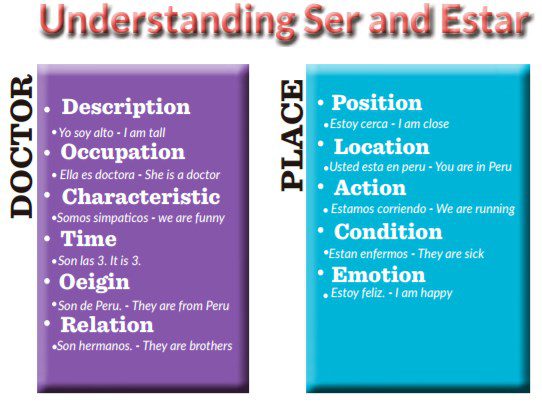
Spanish: Verbs to Live By
So you are going along learning this word and that, catching phrases, repeating a couple and beginning to understand basic concepts. You have officially leveled up. If you have not, go back and repeat and repeat until you arrive at it. Welcome to level two. Now you need to start reading as much as possible, watching Spanish programming with Spanish subtitles, listening and singing along with songs, even learning what the lyrics mean and talking to everyone who will give you an ear. The time has come to befriend some verbs. It is good practice to choose around 5 verbs each week, these verbs should be useful for day to day interactions. Remember there is no need to conjugate in the beginning. Just choosing the right verb makes a big difference in being understood. Here are 5 verbs you can add right away that will make life a bit easier.
“To be” is the simplest and most important verb we use in English, it is at the basis of so much speech. It also marks the one truly irregular verb in English, which means it changes from its original depending on who or what is doing the action. You are not supposed to say “I be good”, you change it to am, are and is. Here is the best example in understanding conjugation in Spanish. In Spanish all verbs change according to who is doing the action. With translating “to be” to Spanish there is a further difficulty, there are two verbs that represent “to be”. Go ahead and read that again and let it sink in. The most important verb in the English language is actually two verbs in Spanish depending on what you are trying to say. In the simplest terms, ser is for things that are permanent in nature and estar is for things that have a quality of change. This dastardly duo may trip you up but use the adjoining mnemonic device to help you to start using them correctly.
A common error that English speakers make is confusing ser, to be and tener, to have. In basic terms tener adding an “a” to it and you change its use. “Ir a” means going to, so you can add that to any verb or place and you are on your way. Voy a la playa – I am going to the beach. This little trick helps you start formulating sentences quickly and easily. Another verb many of us learned through a Chihuahua who really liked tacos is the verb querer. Querer is also a verb that can help you communicate your wants and needs. With “Yo quiero” you can add any verb or thing and be one step closer to fulfilling your wants and dreams. If you are at a restaurant and you want to sound a bit more polite you can say “Quisiera”, as in Quisiera una quesadilla- I would like a quesadilla .
Learning verbs is the cornerstone to becoming truly bilingual. You can further deepen your love affair with verbs by visiting conjugation.com and watch how they change and shift according to time. You can go to studyspanish.com and have a more in-depth explanation and online practice. Learning a language is all about perspective. If you fall in love with the language, learning becomes swift and painless. Add some verbage to your week and you will see the difference.
Spanish Pronunciations: Vowels and Consonants
Spanish – Great minds think alike
Spanish – A dash of Pura Vida
Spanish – Step up your game
Spanish – Leveling Up, the 20/90 Challenge
Spanish- Tips for a New Year of Language Learning
Spanish – Relax, Engage, Learn
Spanish – Banter, a pura vida life skill
Spanish – Here’s looking at you, kid
Spanish – Yearning for Learning
Spanish – Seven Motivating Reasons to Start Learning today
Spanish – Beware of false friends
Breaking the barriers of learning Spanish
